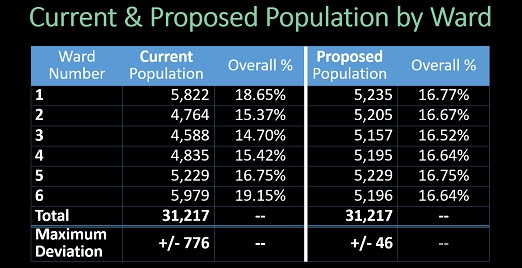Ward Redistricting for the City of Shawnee, Oklahoma
On February 12, 2024, the City Commission approved the proposed adjustments to Shawnee's Ward boundaries. Citizens can learn which ward they reside in by visiting the Ward Map.
-----------------------------
On February 12, 2024, at 6:00 pm, the City of Shawnee will conduct a Special Call City Commission Meeting to consider the approval of proposed adjustments to Shawnee's Ward boundaries. The City of Shawnee, like many municipalities across the United States, undergoes a redistricting process to adjust ward boundaries following the Federal Decennial Census in 2020. This process is guided by the City Charter as well as Oklahoma State law. The redistricting ensures fair representation by aligning ward populations with demographic changes.
Find Your Ward - For Shawnee residents interested in learning which ward they reside in, the Shawnee's Citizen Request Portal and its "Find Your Ward" functionality can be of assistance.
Importance of Wards - In general, wards divide the City of Shawnee for the purpose of local governance, and the ward boundaries must be periodically adjusted to prevent unequal representation. The redistricting process ensures the population in each of the six wards remains proportionate. Please follow the link for a map of the current wards in the City of Shawnee.
Decennial Census Triggers Redistricting - Public Law 94-171 is crucial for legislative redistricting in the United States. Enacted in 1975, it mandates that the U.S. Census Bureau provide redistricting data to states and municipalities every ten years. Following the publication of the most recent Census data, the City of Shawnee initiated the ward redistricting to reflect population shifts and maintain equitable representation.
2020 Census Data - The Census data used during the redistricting can be viewed online. This block-level data is provided at the smallest geographic unit at which the U.S. Census Bureau makes anonymous, total population data available.
Population Growth Impact - The redistricting in Shawnee is driven by population changes, including those associated with annexations and de-annexations.
- Between 2010 and 2020, the City of Shawnee grew from a population of 29,551 to a population of 31,217. This is representative of a 5.6% growth, which primarily impacted the norther City wards (1 and 6).
- In 2021, the City of Shawnee de-annexed territory south of the Canadian River, which primarily impacted the southern two City wards (3 and 4).
Redistricting Process - The process of adjusting Shawnee ward boundaries occurred incrementally.
- The ideal population number for each ward was calculated to be 5,203 residents.
- To arrive at essentially equal population numbers across all wards, a maximum deviation threshold of 1.0% was set, which equals +/- 52 persons or less.
- Based on the 2020 redistricting data, it was determined that Ward 5 already fell within the desired population range and required no changes.
- Wards 3 and 4 had been significantly impacted by the de-annexation of southern territory. Therefore, Ward 4 was adjusted westward, and Ward 3's boundary was moved northward until the target range was reached.
- Ward 2 was adjusted northward to absorb some of the growth previously focused on Wards 1 and 6.
- And lastly, the boundary between Wards 1 and 6 was aligned to coincide with Kickapoo Street.
The resulting population changes are captured in the table shown below.
The resulting boundary adjustments are captured in the proposed ward boundary map, which includes the current ward boundaries for ease of comparison. A zoomed-in version of the same map, focused on the areas of proposed changes, was also created.
City Commission Approval Required - The Shawnee Board of City Commissioners is tasked with approving the proposed new ward boundaries. Residents can stay informed by attending the Public Hearing on February 12, 2024, to learn first-hand about the data and rationale behind proposed changes.
